The Role of Nurses in Preventing Adolescent Alcoholism in Australia
VerifiedAdded on 2020/04/07
|18
|4840
|228
Report
AI Summary
This report analyzes the crucial role of nurses in preventing alcoholism among adolescents in Australia. It begins by highlighting the prevalence of adolescent alcohol misuse and its associated risks, including physical, social, and emotional harms. The report then delves into the various factors influencing alcoholism, such as socioeconomic conditions, physiological and genetic predispositions, individual characteristics, family dynamics, parenting styles, academic achievements, and peer pressure. It emphasizes the significance of the Ottawa Charter for Health Promotion in guiding prevention strategies. The report examines how nurses can utilize the Ottawa Charter's five action areas—building healthy public policy, creating supportive environments, strengthening community action, developing personal skills, and reorienting health services—to support families and communities in addressing alcohol misuse. It highlights the importance of nurses in advocating for policy changes, fostering partnerships, and implementing community-based interventions to reduce the incidence of adolescent alcoholism in Australia. The report stresses the need for comprehensive strategies that address individual, family, and societal factors to effectively combat this public health issue.
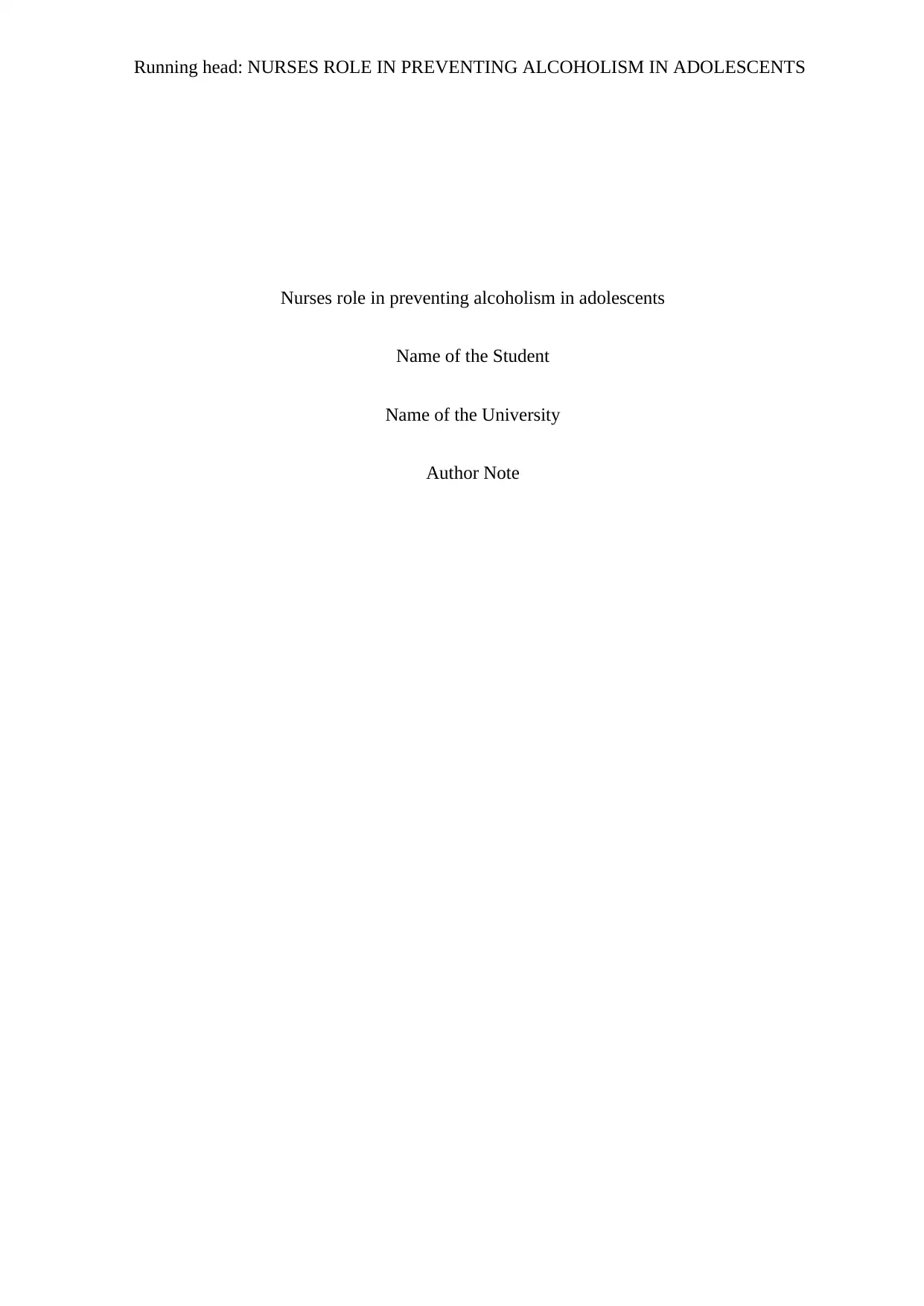
Running head: NURSES ROLE IN PREVENTING ALCOHOLISM IN ADOLESCENTS
Nurses role in preventing alcoholism in adolescents
Name of the Student
Name of the University
Author Note
Nurses role in preventing alcoholism in adolescents
Name of the Student
Name of the University
Author Note
Paraphrase This Document
Need a fresh take? Get an instant paraphrase of this document with our AI Paraphraser
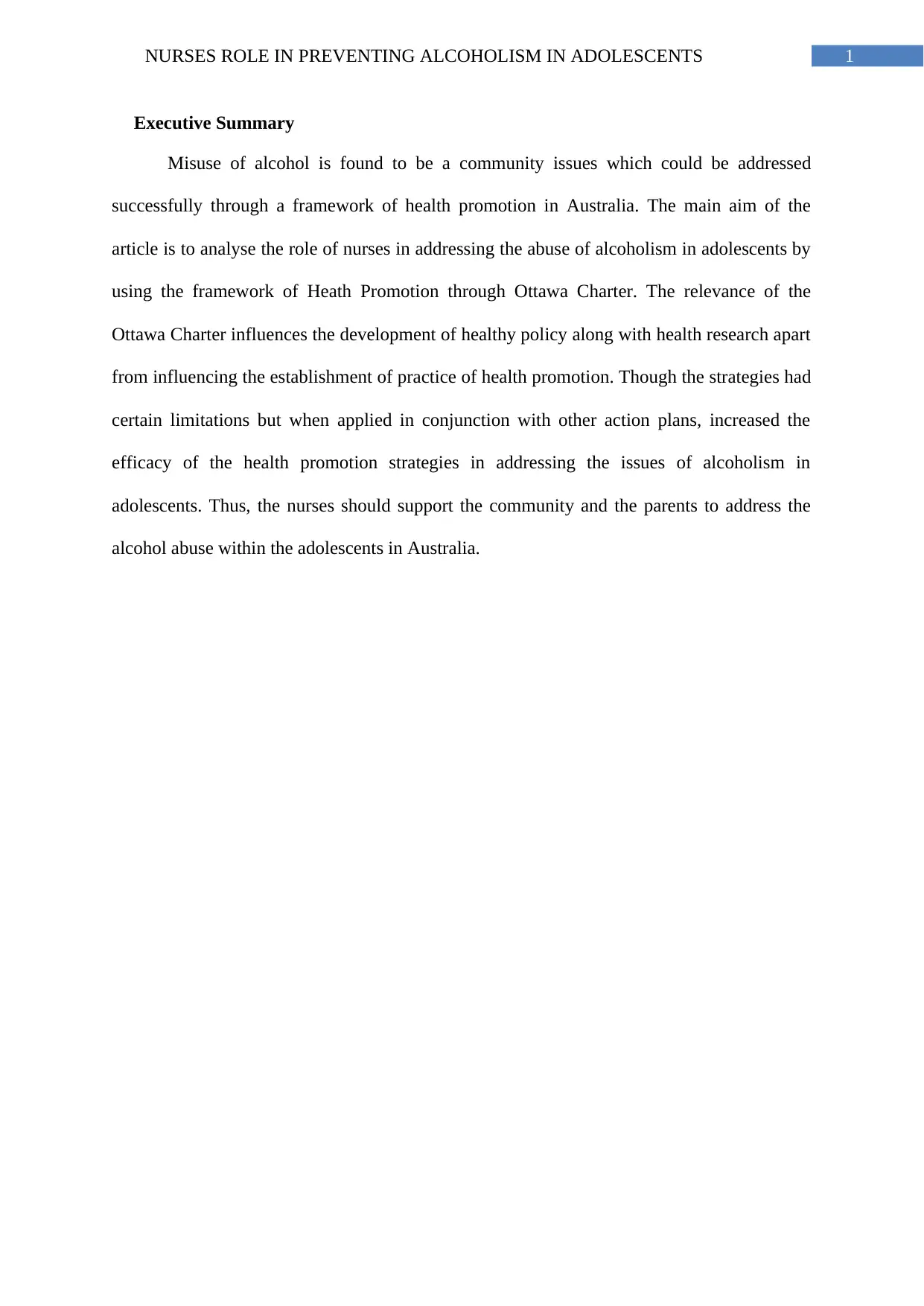
1NURSES ROLE IN PREVENTING ALCOHOLISM IN ADOLESCENTS
Executive Summary
Misuse of alcohol is found to be a community issues which could be addressed
successfully through a framework of health promotion in Australia. The main aim of the
article is to analyse the role of nurses in addressing the abuse of alcoholism in adolescents by
using the framework of Heath Promotion through Ottawa Charter. The relevance of the
Ottawa Charter influences the development of healthy policy along with health research apart
from influencing the establishment of practice of health promotion. Though the strategies had
certain limitations but when applied in conjunction with other action plans, increased the
efficacy of the health promotion strategies in addressing the issues of alcoholism in
adolescents. Thus, the nurses should support the community and the parents to address the
alcohol abuse within the adolescents in Australia.
Executive Summary
Misuse of alcohol is found to be a community issues which could be addressed
successfully through a framework of health promotion in Australia. The main aim of the
article is to analyse the role of nurses in addressing the abuse of alcoholism in adolescents by
using the framework of Heath Promotion through Ottawa Charter. The relevance of the
Ottawa Charter influences the development of healthy policy along with health research apart
from influencing the establishment of practice of health promotion. Though the strategies had
certain limitations but when applied in conjunction with other action plans, increased the
efficacy of the health promotion strategies in addressing the issues of alcoholism in
adolescents. Thus, the nurses should support the community and the parents to address the
alcohol abuse within the adolescents in Australia.
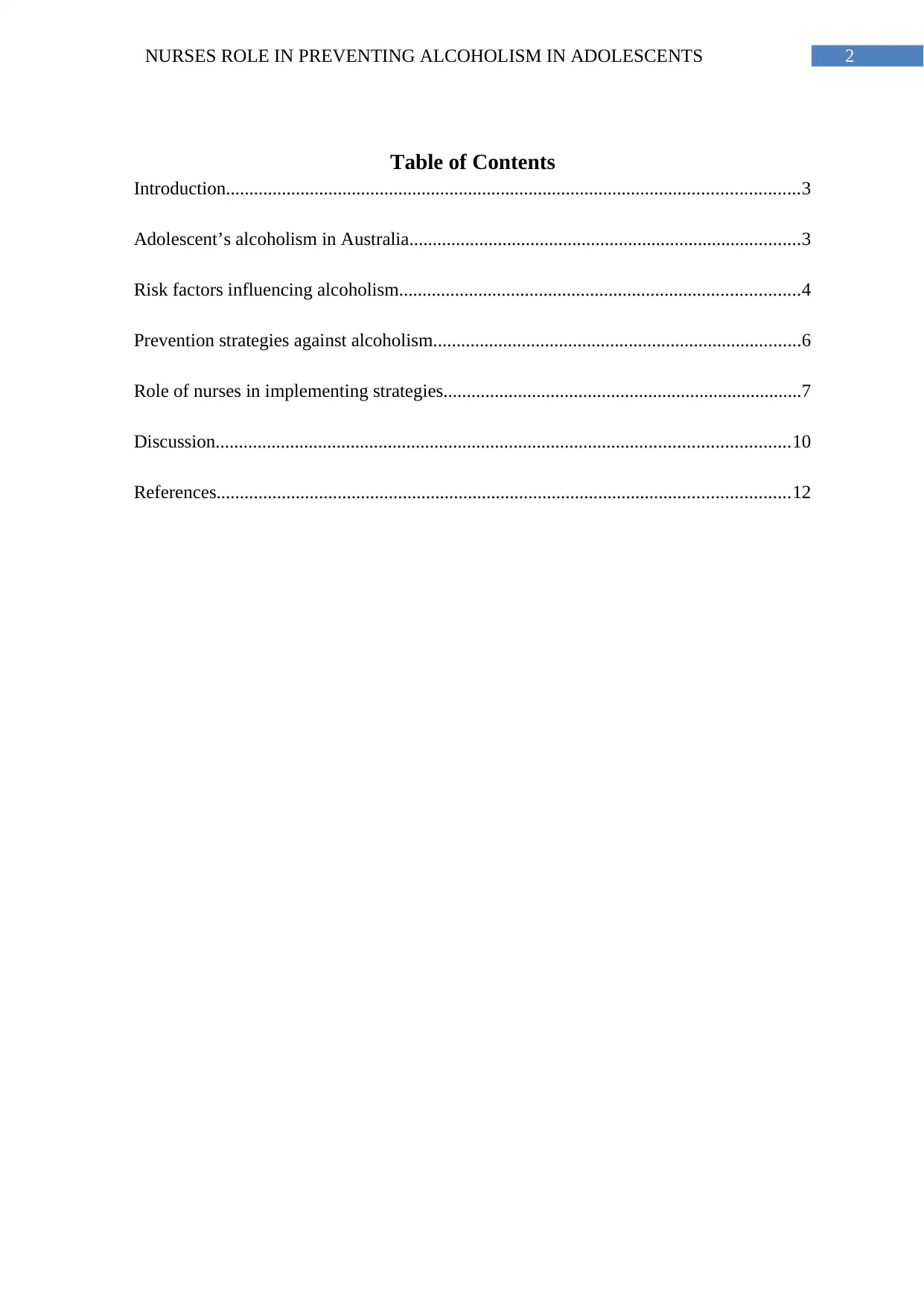
2NURSES ROLE IN PREVENTING ALCOHOLISM IN ADOLESCENTS
Table of Contents
Introduction...........................................................................................................................3
Adolescent’s alcoholism in Australia....................................................................................3
Risk factors influencing alcoholism......................................................................................4
Prevention strategies against alcoholism...............................................................................6
Role of nurses in implementing strategies.............................................................................7
Discussion...........................................................................................................................10
References...........................................................................................................................12
Table of Contents
Introduction...........................................................................................................................3
Adolescent’s alcoholism in Australia....................................................................................3
Risk factors influencing alcoholism......................................................................................4
Prevention strategies against alcoholism...............................................................................6
Role of nurses in implementing strategies.............................................................................7
Discussion...........................................................................................................................10
References...........................................................................................................................12
⊘ This is a preview!⊘
Do you want full access?
Subscribe today to unlock all pages.

Trusted by 1+ million students worldwide
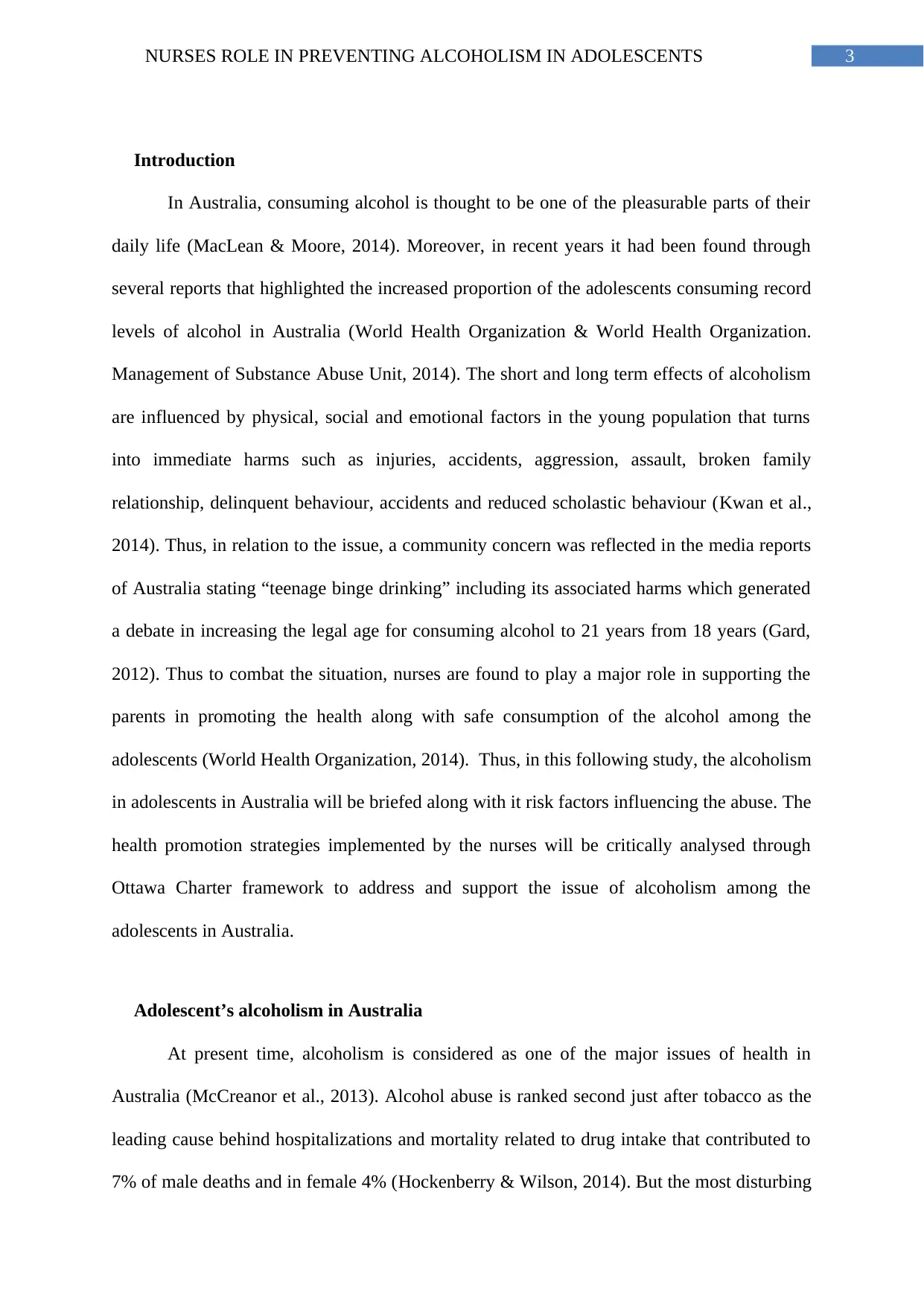
3NURSES ROLE IN PREVENTING ALCOHOLISM IN ADOLESCENTS
Introduction
In Australia, consuming alcohol is thought to be one of the pleasurable parts of their
daily life (MacLean & Moore, 2014). Moreover, in recent years it had been found through
several reports that highlighted the increased proportion of the adolescents consuming record
levels of alcohol in Australia (World Health Organization & World Health Organization.
Management of Substance Abuse Unit, 2014). The short and long term effects of alcoholism
are influenced by physical, social and emotional factors in the young population that turns
into immediate harms such as injuries, accidents, aggression, assault, broken family
relationship, delinquent behaviour, accidents and reduced scholastic behaviour (Kwan et al.,
2014). Thus, in relation to the issue, a community concern was reflected in the media reports
of Australia stating “teenage binge drinking” including its associated harms which generated
a debate in increasing the legal age for consuming alcohol to 21 years from 18 years (Gard,
2012). Thus to combat the situation, nurses are found to play a major role in supporting the
parents in promoting the health along with safe consumption of the alcohol among the
adolescents (World Health Organization, 2014). Thus, in this following study, the alcoholism
in adolescents in Australia will be briefed along with it risk factors influencing the abuse. The
health promotion strategies implemented by the nurses will be critically analysed through
Ottawa Charter framework to address and support the issue of alcoholism among the
adolescents in Australia.
Adolescent’s alcoholism in Australia
At present time, alcoholism is considered as one of the major issues of health in
Australia (McCreanor et al., 2013). Alcohol abuse is ranked second just after tobacco as the
leading cause behind hospitalizations and mortality related to drug intake that contributed to
7% of male deaths and in female 4% (Hockenberry & Wilson, 2014). But the most disturbing
Introduction
In Australia, consuming alcohol is thought to be one of the pleasurable parts of their
daily life (MacLean & Moore, 2014). Moreover, in recent years it had been found through
several reports that highlighted the increased proportion of the adolescents consuming record
levels of alcohol in Australia (World Health Organization & World Health Organization.
Management of Substance Abuse Unit, 2014). The short and long term effects of alcoholism
are influenced by physical, social and emotional factors in the young population that turns
into immediate harms such as injuries, accidents, aggression, assault, broken family
relationship, delinquent behaviour, accidents and reduced scholastic behaviour (Kwan et al.,
2014). Thus, in relation to the issue, a community concern was reflected in the media reports
of Australia stating “teenage binge drinking” including its associated harms which generated
a debate in increasing the legal age for consuming alcohol to 21 years from 18 years (Gard,
2012). Thus to combat the situation, nurses are found to play a major role in supporting the
parents in promoting the health along with safe consumption of the alcohol among the
adolescents (World Health Organization, 2014). Thus, in this following study, the alcoholism
in adolescents in Australia will be briefed along with it risk factors influencing the abuse. The
health promotion strategies implemented by the nurses will be critically analysed through
Ottawa Charter framework to address and support the issue of alcoholism among the
adolescents in Australia.
Adolescent’s alcoholism in Australia
At present time, alcoholism is considered as one of the major issues of health in
Australia (McCreanor et al., 2013). Alcohol abuse is ranked second just after tobacco as the
leading cause behind hospitalizations and mortality related to drug intake that contributed to
7% of male deaths and in female 4% (Hockenberry & Wilson, 2014). But the most disturbing
Paraphrase This Document
Need a fresh take? Get an instant paraphrase of this document with our AI Paraphraser
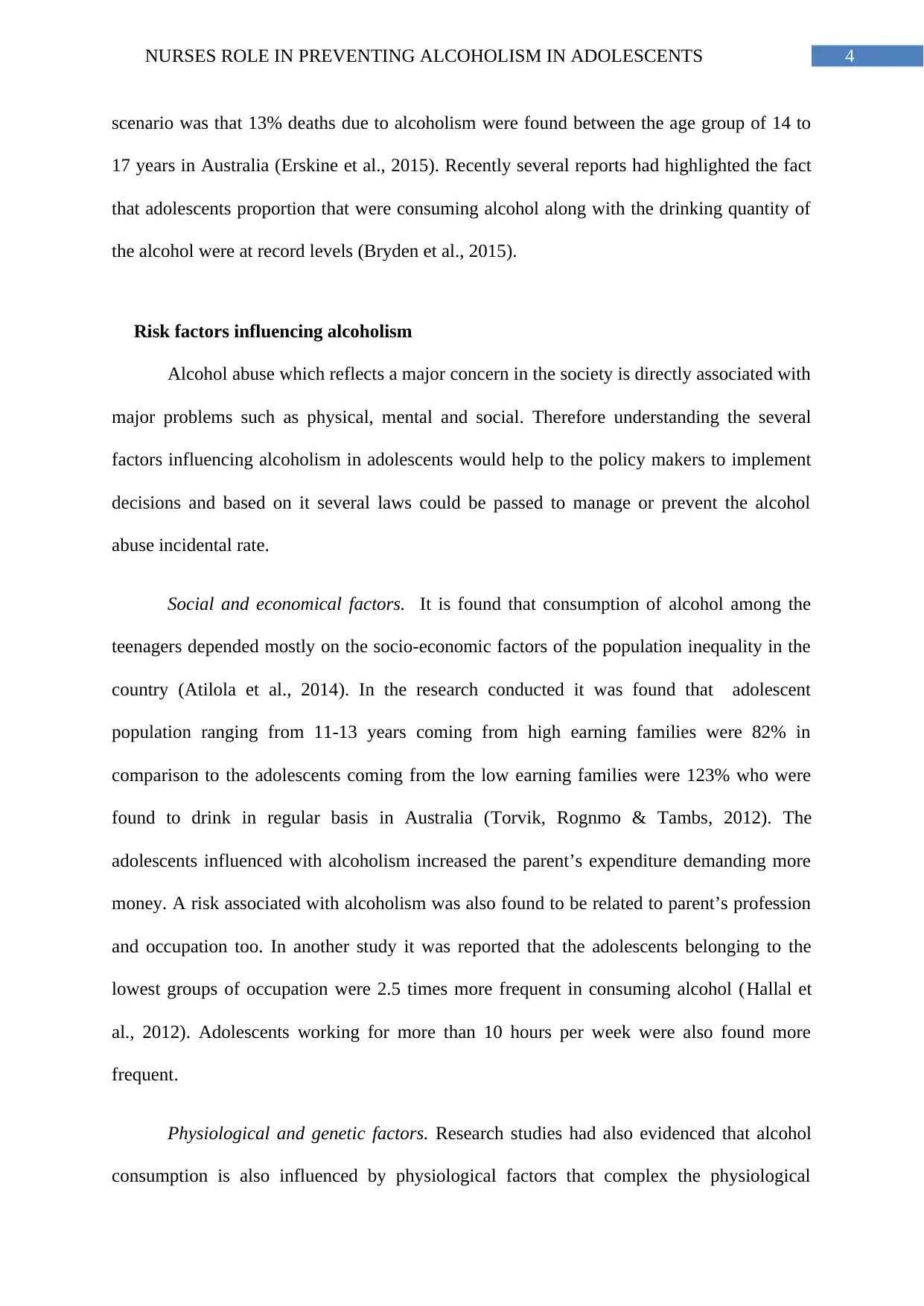
4NURSES ROLE IN PREVENTING ALCOHOLISM IN ADOLESCENTS
scenario was that 13% deaths due to alcoholism were found between the age group of 14 to
17 years in Australia (Erskine et al., 2015). Recently several reports had highlighted the fact
that adolescents proportion that were consuming alcohol along with the drinking quantity of
the alcohol were at record levels (Bryden et al., 2015).
Risk factors influencing alcoholism
Alcohol abuse which reflects a major concern in the society is directly associated with
major problems such as physical, mental and social. Therefore understanding the several
factors influencing alcoholism in adolescents would help to the policy makers to implement
decisions and based on it several laws could be passed to manage or prevent the alcohol
abuse incidental rate.
Social and economical factors. It is found that consumption of alcohol among the
teenagers depended mostly on the socio-economic factors of the population inequality in the
country (Atilola et al., 2014). In the research conducted it was found that adolescent
population ranging from 11-13 years coming from high earning families were 82% in
comparison to the adolescents coming from the low earning families were 123% who were
found to drink in regular basis in Australia (Torvik, Rognmo & Tambs, 2012). The
adolescents influenced with alcoholism increased the parent’s expenditure demanding more
money. A risk associated with alcoholism was also found to be related to parent’s profession
and occupation too. In another study it was reported that the adolescents belonging to the
lowest groups of occupation were 2.5 times more frequent in consuming alcohol (Hallal et
al., 2012). Adolescents working for more than 10 hours per week were also found more
frequent.
Physiological and genetic factors. Research studies had also evidenced that alcohol
consumption is also influenced by physiological factors that complex the physiological
scenario was that 13% deaths due to alcoholism were found between the age group of 14 to
17 years in Australia (Erskine et al., 2015). Recently several reports had highlighted the fact
that adolescents proportion that were consuming alcohol along with the drinking quantity of
the alcohol were at record levels (Bryden et al., 2015).
Risk factors influencing alcoholism
Alcohol abuse which reflects a major concern in the society is directly associated with
major problems such as physical, mental and social. Therefore understanding the several
factors influencing alcoholism in adolescents would help to the policy makers to implement
decisions and based on it several laws could be passed to manage or prevent the alcohol
abuse incidental rate.
Social and economical factors. It is found that consumption of alcohol among the
teenagers depended mostly on the socio-economic factors of the population inequality in the
country (Atilola et al., 2014). In the research conducted it was found that adolescent
population ranging from 11-13 years coming from high earning families were 82% in
comparison to the adolescents coming from the low earning families were 123% who were
found to drink in regular basis in Australia (Torvik, Rognmo & Tambs, 2012). The
adolescents influenced with alcoholism increased the parent’s expenditure demanding more
money. A risk associated with alcoholism was also found to be related to parent’s profession
and occupation too. In another study it was reported that the adolescents belonging to the
lowest groups of occupation were 2.5 times more frequent in consuming alcohol (Hallal et
al., 2012). Adolescents working for more than 10 hours per week were also found more
frequent.
Physiological and genetic factors. Research studies had also evidenced that alcohol
consumption is also influenced by physiological factors that complex the physiological
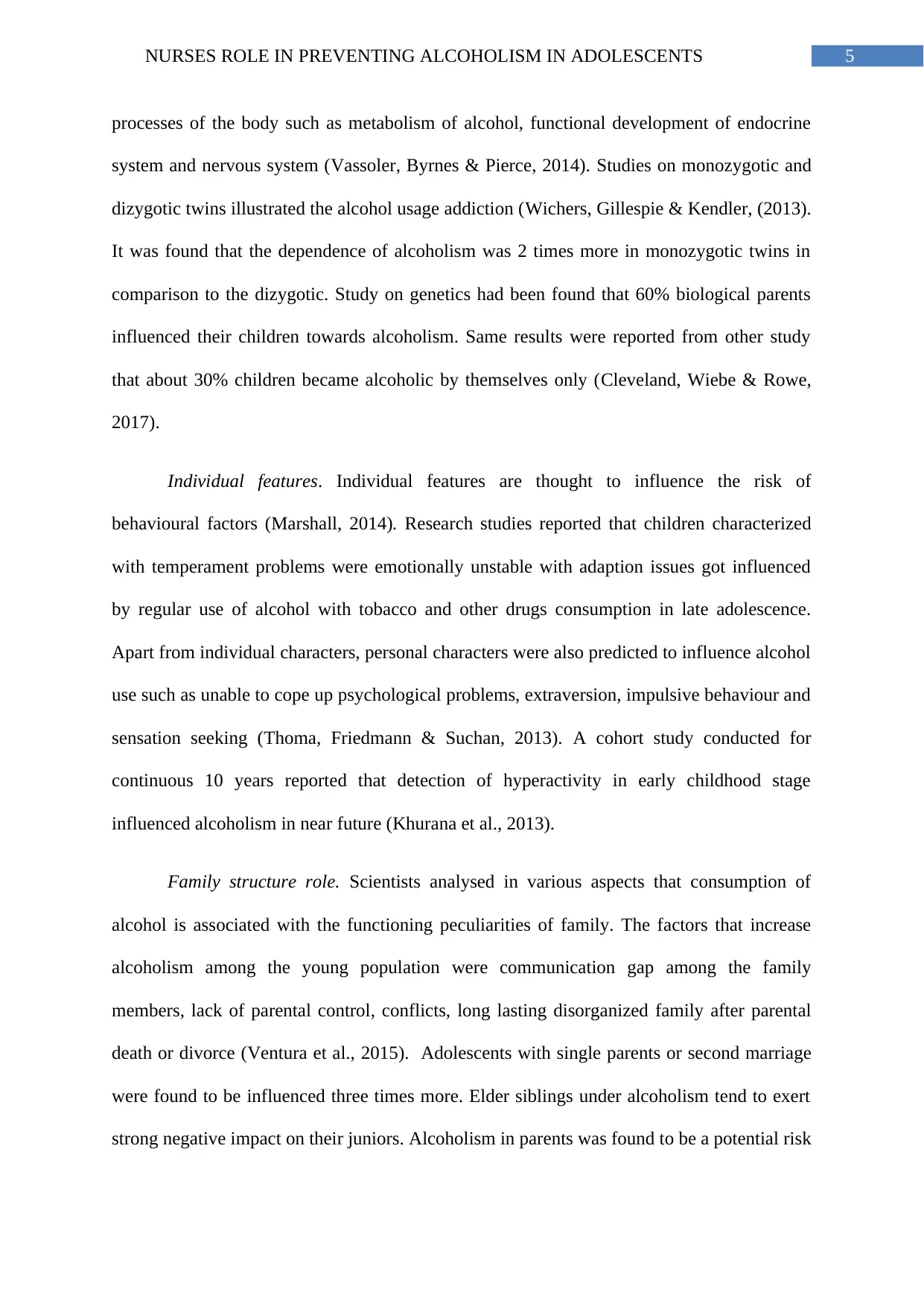
5NURSES ROLE IN PREVENTING ALCOHOLISM IN ADOLESCENTS
processes of the body such as metabolism of alcohol, functional development of endocrine
system and nervous system (Vassoler, Byrnes & Pierce, 2014). Studies on monozygotic and
dizygotic twins illustrated the alcohol usage addiction (Wichers, Gillespie & Kendler, (2013).
It was found that the dependence of alcoholism was 2 times more in monozygotic twins in
comparison to the dizygotic. Study on genetics had been found that 60% biological parents
influenced their children towards alcoholism. Same results were reported from other study
that about 30% children became alcoholic by themselves only (Cleveland, Wiebe & Rowe,
2017).
Individual features. Individual features are thought to influence the risk of
behavioural factors (Marshall, 2014). Research studies reported that children characterized
with temperament problems were emotionally unstable with adaption issues got influenced
by regular use of alcohol with tobacco and other drugs consumption in late adolescence.
Apart from individual characters, personal characters were also predicted to influence alcohol
use such as unable to cope up psychological problems, extraversion, impulsive behaviour and
sensation seeking (Thoma, Friedmann & Suchan, 2013). A cohort study conducted for
continuous 10 years reported that detection of hyperactivity in early childhood stage
influenced alcoholism in near future (Khurana et al., 2013).
Family structure role. Scientists analysed in various aspects that consumption of
alcohol is associated with the functioning peculiarities of family. The factors that increase
alcoholism among the young population were communication gap among the family
members, lack of parental control, conflicts, long lasting disorganized family after parental
death or divorce (Ventura et al., 2015). Adolescents with single parents or second marriage
were found to be influenced three times more. Elder siblings under alcoholism tend to exert
strong negative impact on their juniors. Alcoholism in parents was found to be a potential risk
processes of the body such as metabolism of alcohol, functional development of endocrine
system and nervous system (Vassoler, Byrnes & Pierce, 2014). Studies on monozygotic and
dizygotic twins illustrated the alcohol usage addiction (Wichers, Gillespie & Kendler, (2013).
It was found that the dependence of alcoholism was 2 times more in monozygotic twins in
comparison to the dizygotic. Study on genetics had been found that 60% biological parents
influenced their children towards alcoholism. Same results were reported from other study
that about 30% children became alcoholic by themselves only (Cleveland, Wiebe & Rowe,
2017).
Individual features. Individual features are thought to influence the risk of
behavioural factors (Marshall, 2014). Research studies reported that children characterized
with temperament problems were emotionally unstable with adaption issues got influenced
by regular use of alcohol with tobacco and other drugs consumption in late adolescence.
Apart from individual characters, personal characters were also predicted to influence alcohol
use such as unable to cope up psychological problems, extraversion, impulsive behaviour and
sensation seeking (Thoma, Friedmann & Suchan, 2013). A cohort study conducted for
continuous 10 years reported that detection of hyperactivity in early childhood stage
influenced alcoholism in near future (Khurana et al., 2013).
Family structure role. Scientists analysed in various aspects that consumption of
alcohol is associated with the functioning peculiarities of family. The factors that increase
alcoholism among the young population were communication gap among the family
members, lack of parental control, conflicts, long lasting disorganized family after parental
death or divorce (Ventura et al., 2015). Adolescents with single parents or second marriage
were found to be influenced three times more. Elder siblings under alcoholism tend to exert
strong negative impact on their juniors. Alcoholism in parents was found to be a potential risk
⊘ This is a preview!⊘
Do you want full access?
Subscribe today to unlock all pages.

Trusted by 1+ million students worldwide
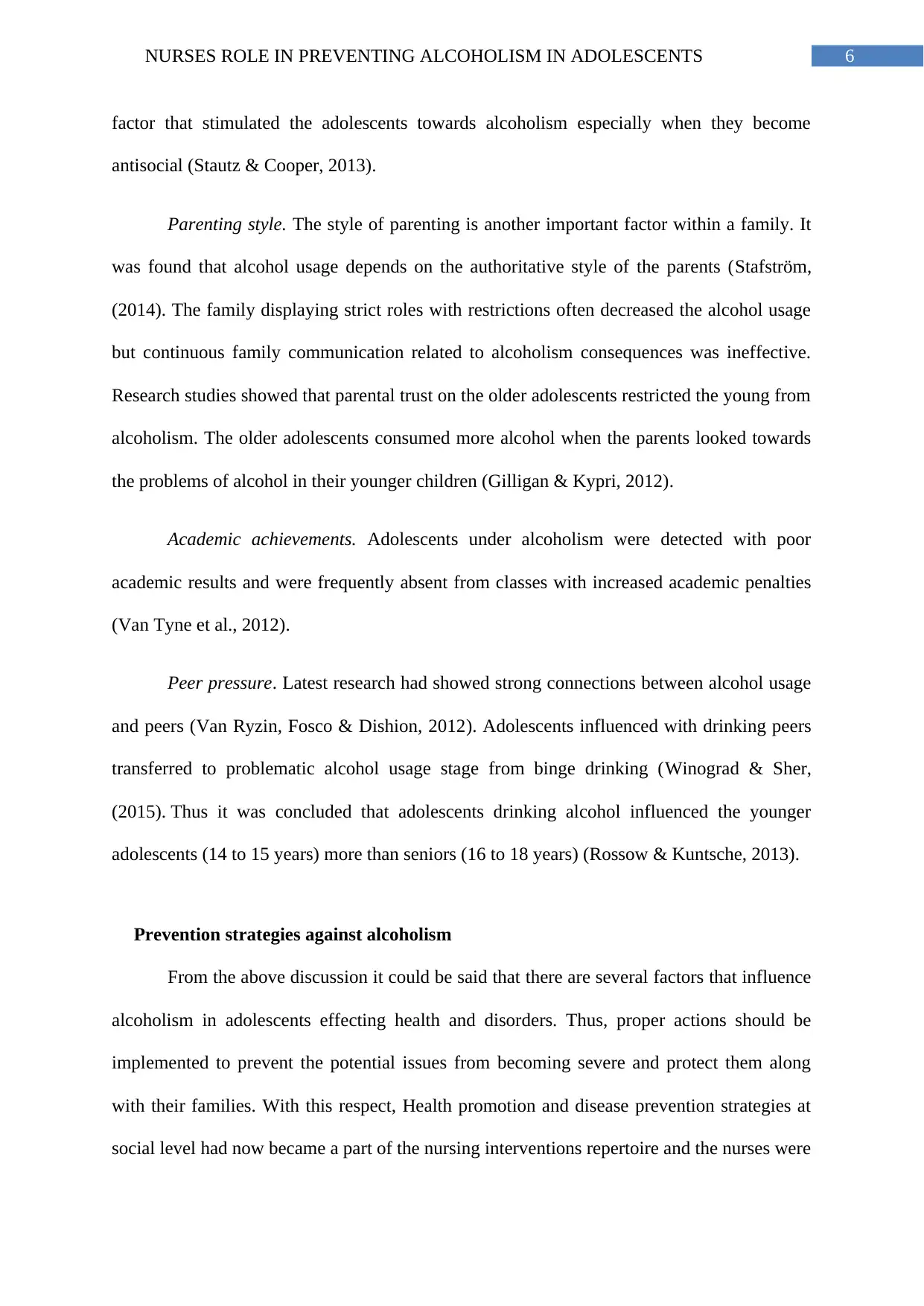
6NURSES ROLE IN PREVENTING ALCOHOLISM IN ADOLESCENTS
factor that stimulated the adolescents towards alcoholism especially when they become
antisocial (Stautz & Cooper, 2013).
Parenting style. The style of parenting is another important factor within a family. It
was found that alcohol usage depends on the authoritative style of the parents (Stafström,
(2014). The family displaying strict roles with restrictions often decreased the alcohol usage
but continuous family communication related to alcoholism consequences was ineffective.
Research studies showed that parental trust on the older adolescents restricted the young from
alcoholism. The older adolescents consumed more alcohol when the parents looked towards
the problems of alcohol in their younger children (Gilligan & Kypri, 2012).
Academic achievements. Adolescents under alcoholism were detected with poor
academic results and were frequently absent from classes with increased academic penalties
(Van Tyne et al., 2012).
Peer pressure. Latest research had showed strong connections between alcohol usage
and peers (Van Ryzin, Fosco & Dishion, 2012). Adolescents influenced with drinking peers
transferred to problematic alcohol usage stage from binge drinking (Winograd & Sher,
(2015). Thus it was concluded that adolescents drinking alcohol influenced the younger
adolescents (14 to 15 years) more than seniors (16 to 18 years) (Rossow & Kuntsche, 2013).
Prevention strategies against alcoholism
From the above discussion it could be said that there are several factors that influence
alcoholism in adolescents effecting health and disorders. Thus, proper actions should be
implemented to prevent the potential issues from becoming severe and protect them along
with their families. With this respect, Health promotion and disease prevention strategies at
social level had now became a part of the nursing interventions repertoire and the nurses were
factor that stimulated the adolescents towards alcoholism especially when they become
antisocial (Stautz & Cooper, 2013).
Parenting style. The style of parenting is another important factor within a family. It
was found that alcohol usage depends on the authoritative style of the parents (Stafström,
(2014). The family displaying strict roles with restrictions often decreased the alcohol usage
but continuous family communication related to alcoholism consequences was ineffective.
Research studies showed that parental trust on the older adolescents restricted the young from
alcoholism. The older adolescents consumed more alcohol when the parents looked towards
the problems of alcohol in their younger children (Gilligan & Kypri, 2012).
Academic achievements. Adolescents under alcoholism were detected with poor
academic results and were frequently absent from classes with increased academic penalties
(Van Tyne et al., 2012).
Peer pressure. Latest research had showed strong connections between alcohol usage
and peers (Van Ryzin, Fosco & Dishion, 2012). Adolescents influenced with drinking peers
transferred to problematic alcohol usage stage from binge drinking (Winograd & Sher,
(2015). Thus it was concluded that adolescents drinking alcohol influenced the younger
adolescents (14 to 15 years) more than seniors (16 to 18 years) (Rossow & Kuntsche, 2013).
Prevention strategies against alcoholism
From the above discussion it could be said that there are several factors that influence
alcoholism in adolescents effecting health and disorders. Thus, proper actions should be
implemented to prevent the potential issues from becoming severe and protect them along
with their families. With this respect, Health promotion and disease prevention strategies at
social level had now became a part of the nursing interventions repertoire and the nurses were
Paraphrase This Document
Need a fresh take? Get an instant paraphrase of this document with our AI Paraphraser
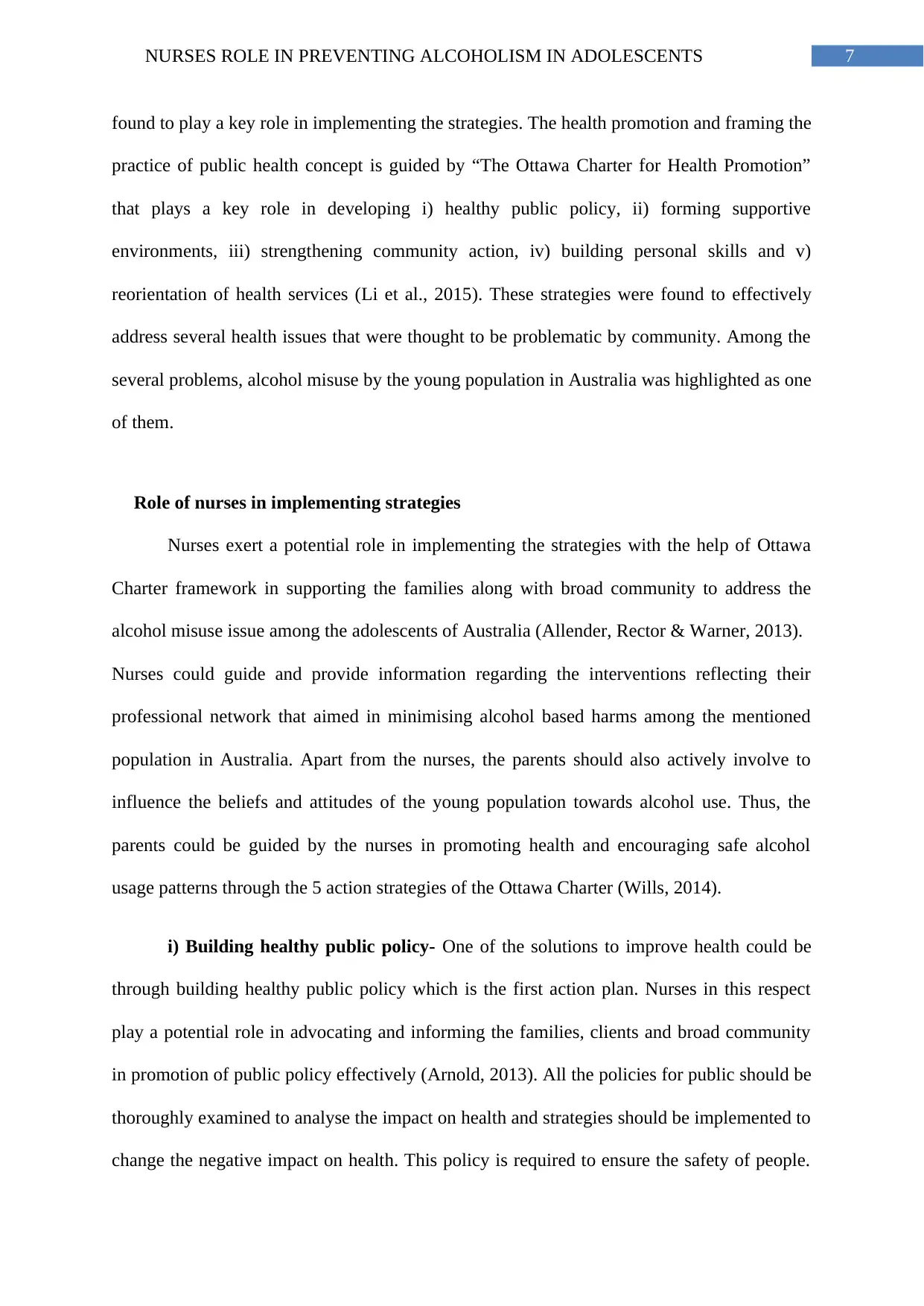
7NURSES ROLE IN PREVENTING ALCOHOLISM IN ADOLESCENTS
found to play a key role in implementing the strategies. The health promotion and framing the
practice of public health concept is guided by “The Ottawa Charter for Health Promotion”
that plays a key role in developing i) healthy public policy, ii) forming supportive
environments, iii) strengthening community action, iv) building personal skills and v)
reorientation of health services (Li et al., 2015). These strategies were found to effectively
address several health issues that were thought to be problematic by community. Among the
several problems, alcohol misuse by the young population in Australia was highlighted as one
of them.
Role of nurses in implementing strategies
Nurses exert a potential role in implementing the strategies with the help of Ottawa
Charter framework in supporting the families along with broad community to address the
alcohol misuse issue among the adolescents of Australia (Allender, Rector & Warner, 2013).
Nurses could guide and provide information regarding the interventions reflecting their
professional network that aimed in minimising alcohol based harms among the mentioned
population in Australia. Apart from the nurses, the parents should also actively involve to
influence the beliefs and attitudes of the young population towards alcohol use. Thus, the
parents could be guided by the nurses in promoting health and encouraging safe alcohol
usage patterns through the 5 action strategies of the Ottawa Charter (Wills, 2014).
i) Building healthy public policy- One of the solutions to improve health could be
through building healthy public policy which is the first action plan. Nurses in this respect
play a potential role in advocating and informing the families, clients and broad community
in promotion of public policy effectively (Arnold, 2013). All the policies for public should be
thoroughly examined to analyse the impact on health and strategies should be implemented to
change the negative impact on health. This policy is required to ensure the safety of people.
found to play a key role in implementing the strategies. The health promotion and framing the
practice of public health concept is guided by “The Ottawa Charter for Health Promotion”
that plays a key role in developing i) healthy public policy, ii) forming supportive
environments, iii) strengthening community action, iv) building personal skills and v)
reorientation of health services (Li et al., 2015). These strategies were found to effectively
address several health issues that were thought to be problematic by community. Among the
several problems, alcohol misuse by the young population in Australia was highlighted as one
of them.
Role of nurses in implementing strategies
Nurses exert a potential role in implementing the strategies with the help of Ottawa
Charter framework in supporting the families along with broad community to address the
alcohol misuse issue among the adolescents of Australia (Allender, Rector & Warner, 2013).
Nurses could guide and provide information regarding the interventions reflecting their
professional network that aimed in minimising alcohol based harms among the mentioned
population in Australia. Apart from the nurses, the parents should also actively involve to
influence the beliefs and attitudes of the young population towards alcohol use. Thus, the
parents could be guided by the nurses in promoting health and encouraging safe alcohol
usage patterns through the 5 action strategies of the Ottawa Charter (Wills, 2014).
i) Building healthy public policy- One of the solutions to improve health could be
through building healthy public policy which is the first action plan. Nurses in this respect
play a potential role in advocating and informing the families, clients and broad community
in promotion of public policy effectively (Arnold, 2013). All the policies for public should be
thoroughly examined to analyse the impact on health and strategies should be implemented to
change the negative impact on health. This policy is required to ensure the safety of people.
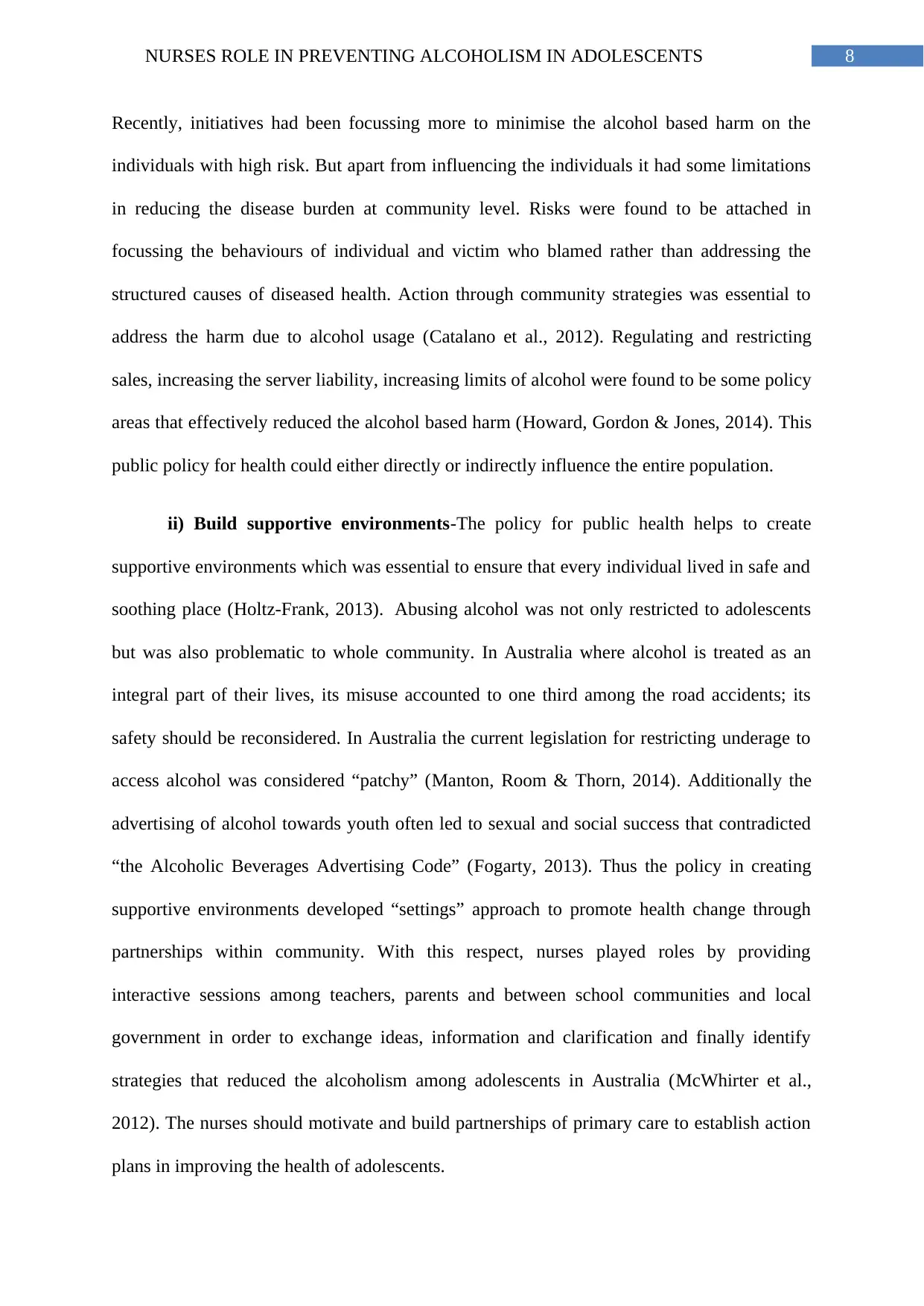
8NURSES ROLE IN PREVENTING ALCOHOLISM IN ADOLESCENTS
Recently, initiatives had been focussing more to minimise the alcohol based harm on the
individuals with high risk. But apart from influencing the individuals it had some limitations
in reducing the disease burden at community level. Risks were found to be attached in
focussing the behaviours of individual and victim who blamed rather than addressing the
structured causes of diseased health. Action through community strategies was essential to
address the harm due to alcohol usage (Catalano et al., 2012). Regulating and restricting
sales, increasing the server liability, increasing limits of alcohol were found to be some policy
areas that effectively reduced the alcohol based harm (Howard, Gordon & Jones, 2014). This
public policy for health could either directly or indirectly influence the entire population.
ii) Build supportive environments-The policy for public health helps to create
supportive environments which was essential to ensure that every individual lived in safe and
soothing place (Holtz-Frank, 2013). Abusing alcohol was not only restricted to adolescents
but was also problematic to whole community. In Australia where alcohol is treated as an
integral part of their lives, its misuse accounted to one third among the road accidents; its
safety should be reconsidered. In Australia the current legislation for restricting underage to
access alcohol was considered “patchy” (Manton, Room & Thorn, 2014). Additionally the
advertising of alcohol towards youth often led to sexual and social success that contradicted
“the Alcoholic Beverages Advertising Code” (Fogarty, 2013). Thus the policy in creating
supportive environments developed “settings” approach to promote health change through
partnerships within community. With this respect, nurses played roles by providing
interactive sessions among teachers, parents and between school communities and local
government in order to exchange ideas, information and clarification and finally identify
strategies that reduced the alcoholism among adolescents in Australia (McWhirter et al.,
2012). The nurses should motivate and build partnerships of primary care to establish action
plans in improving the health of adolescents.
Recently, initiatives had been focussing more to minimise the alcohol based harm on the
individuals with high risk. But apart from influencing the individuals it had some limitations
in reducing the disease burden at community level. Risks were found to be attached in
focussing the behaviours of individual and victim who blamed rather than addressing the
structured causes of diseased health. Action through community strategies was essential to
address the harm due to alcohol usage (Catalano et al., 2012). Regulating and restricting
sales, increasing the server liability, increasing limits of alcohol were found to be some policy
areas that effectively reduced the alcohol based harm (Howard, Gordon & Jones, 2014). This
public policy for health could either directly or indirectly influence the entire population.
ii) Build supportive environments-The policy for public health helps to create
supportive environments which was essential to ensure that every individual lived in safe and
soothing place (Holtz-Frank, 2013). Abusing alcohol was not only restricted to adolescents
but was also problematic to whole community. In Australia where alcohol is treated as an
integral part of their lives, its misuse accounted to one third among the road accidents; its
safety should be reconsidered. In Australia the current legislation for restricting underage to
access alcohol was considered “patchy” (Manton, Room & Thorn, 2014). Additionally the
advertising of alcohol towards youth often led to sexual and social success that contradicted
“the Alcoholic Beverages Advertising Code” (Fogarty, 2013). Thus the policy in creating
supportive environments developed “settings” approach to promote health change through
partnerships within community. With this respect, nurses played roles by providing
interactive sessions among teachers, parents and between school communities and local
government in order to exchange ideas, information and clarification and finally identify
strategies that reduced the alcoholism among adolescents in Australia (McWhirter et al.,
2012). The nurses should motivate and build partnerships of primary care to establish action
plans in improving the health of adolescents.
⊘ This is a preview!⊘
Do you want full access?
Subscribe today to unlock all pages.

Trusted by 1+ million students worldwide
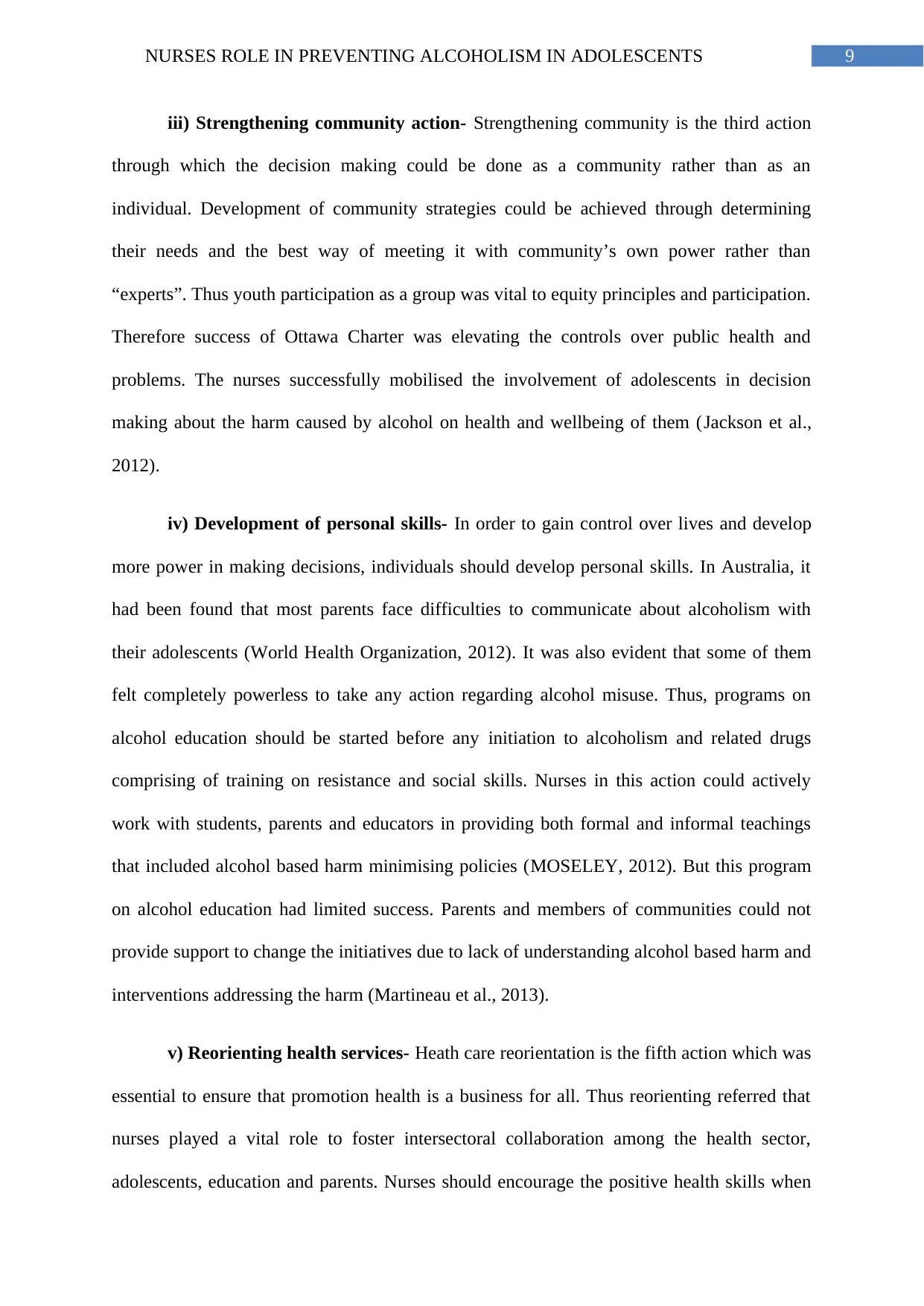
9NURSES ROLE IN PREVENTING ALCOHOLISM IN ADOLESCENTS
iii) Strengthening community action- Strengthening community is the third action
through which the decision making could be done as a community rather than as an
individual. Development of community strategies could be achieved through determining
their needs and the best way of meeting it with community’s own power rather than
“experts”. Thus youth participation as a group was vital to equity principles and participation.
Therefore success of Ottawa Charter was elevating the controls over public health and
problems. The nurses successfully mobilised the involvement of adolescents in decision
making about the harm caused by alcohol on health and wellbeing of them (Jackson et al.,
2012).
iv) Development of personal skills- In order to gain control over lives and develop
more power in making decisions, individuals should develop personal skills. In Australia, it
had been found that most parents face difficulties to communicate about alcoholism with
their adolescents (World Health Organization, 2012). It was also evident that some of them
felt completely powerless to take any action regarding alcohol misuse. Thus, programs on
alcohol education should be started before any initiation to alcoholism and related drugs
comprising of training on resistance and social skills. Nurses in this action could actively
work with students, parents and educators in providing both formal and informal teachings
that included alcohol based harm minimising policies (MOSELEY, 2012). But this program
on alcohol education had limited success. Parents and members of communities could not
provide support to change the initiatives due to lack of understanding alcohol based harm and
interventions addressing the harm (Martineau et al., 2013).
v) Reorienting health services- Heath care reorientation is the fifth action which was
essential to ensure that promotion health is a business for all. Thus reorienting referred that
nurses played a vital role to foster intersectoral collaboration among the health sector,
adolescents, education and parents. Nurses should encourage the positive health skills when
iii) Strengthening community action- Strengthening community is the third action
through which the decision making could be done as a community rather than as an
individual. Development of community strategies could be achieved through determining
their needs and the best way of meeting it with community’s own power rather than
“experts”. Thus youth participation as a group was vital to equity principles and participation.
Therefore success of Ottawa Charter was elevating the controls over public health and
problems. The nurses successfully mobilised the involvement of adolescents in decision
making about the harm caused by alcohol on health and wellbeing of them (Jackson et al.,
2012).
iv) Development of personal skills- In order to gain control over lives and develop
more power in making decisions, individuals should develop personal skills. In Australia, it
had been found that most parents face difficulties to communicate about alcoholism with
their adolescents (World Health Organization, 2012). It was also evident that some of them
felt completely powerless to take any action regarding alcohol misuse. Thus, programs on
alcohol education should be started before any initiation to alcoholism and related drugs
comprising of training on resistance and social skills. Nurses in this action could actively
work with students, parents and educators in providing both formal and informal teachings
that included alcohol based harm minimising policies (MOSELEY, 2012). But this program
on alcohol education had limited success. Parents and members of communities could not
provide support to change the initiatives due to lack of understanding alcohol based harm and
interventions addressing the harm (Martineau et al., 2013).
v) Reorienting health services- Heath care reorientation is the fifth action which was
essential to ensure that promotion health is a business for all. Thus reorienting referred that
nurses played a vital role to foster intersectoral collaboration among the health sector,
adolescents, education and parents. Nurses should encourage the positive health skills when
Paraphrase This Document
Need a fresh take? Get an instant paraphrase of this document with our AI Paraphraser
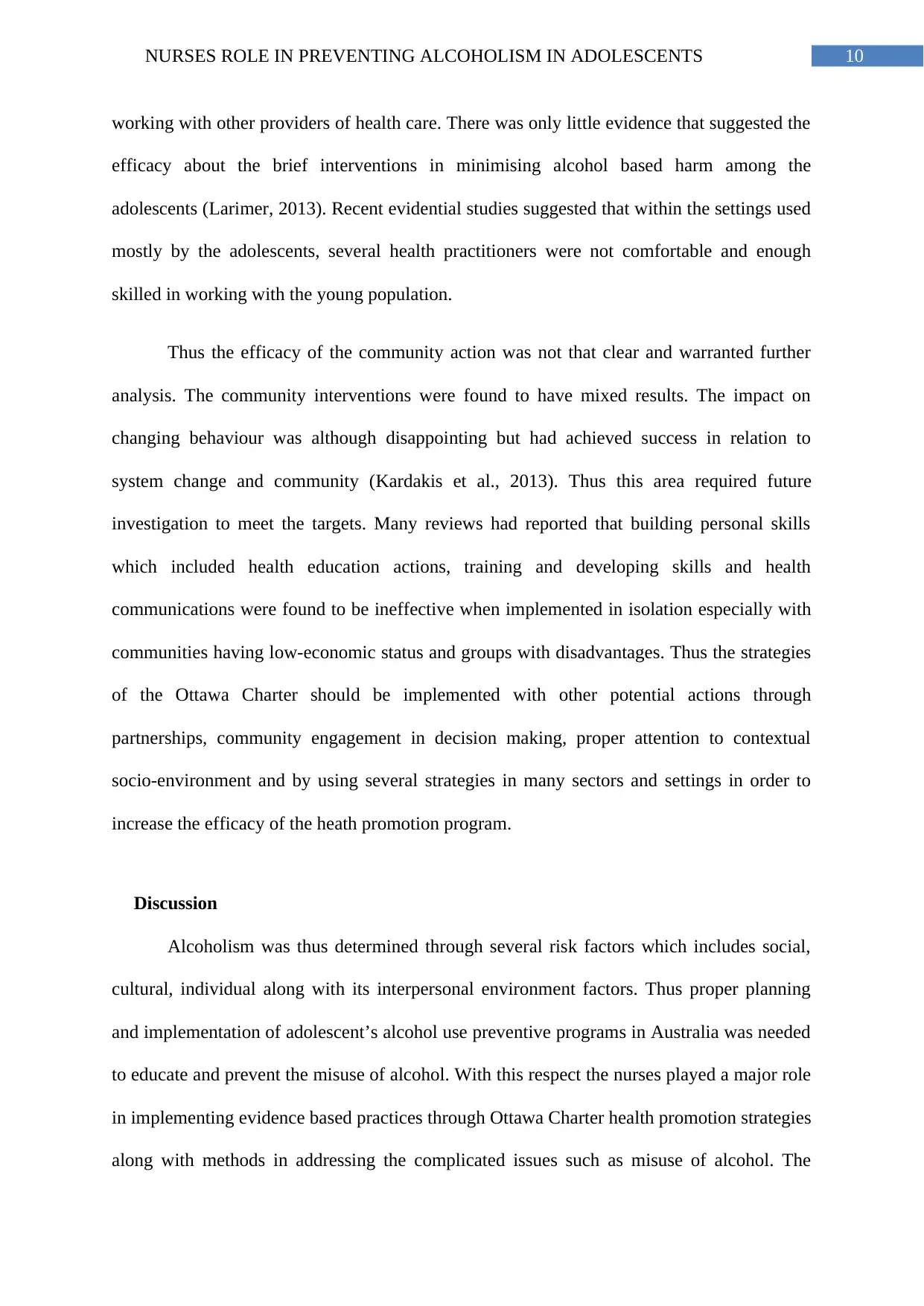
10NURSES ROLE IN PREVENTING ALCOHOLISM IN ADOLESCENTS
working with other providers of health care. There was only little evidence that suggested the
efficacy about the brief interventions in minimising alcohol based harm among the
adolescents (Larimer, 2013). Recent evidential studies suggested that within the settings used
mostly by the adolescents, several health practitioners were not comfortable and enough
skilled in working with the young population.
Thus the efficacy of the community action was not that clear and warranted further
analysis. The community interventions were found to have mixed results. The impact on
changing behaviour was although disappointing but had achieved success in relation to
system change and community (Kardakis et al., 2013). Thus this area required future
investigation to meet the targets. Many reviews had reported that building personal skills
which included health education actions, training and developing skills and health
communications were found to be ineffective when implemented in isolation especially with
communities having low-economic status and groups with disadvantages. Thus the strategies
of the Ottawa Charter should be implemented with other potential actions through
partnerships, community engagement in decision making, proper attention to contextual
socio-environment and by using several strategies in many sectors and settings in order to
increase the efficacy of the heath promotion program.
Discussion
Alcoholism was thus determined through several risk factors which includes social,
cultural, individual along with its interpersonal environment factors. Thus proper planning
and implementation of adolescent’s alcohol use preventive programs in Australia was needed
to educate and prevent the misuse of alcohol. With this respect the nurses played a major role
in implementing evidence based practices through Ottawa Charter health promotion strategies
along with methods in addressing the complicated issues such as misuse of alcohol. The
working with other providers of health care. There was only little evidence that suggested the
efficacy about the brief interventions in minimising alcohol based harm among the
adolescents (Larimer, 2013). Recent evidential studies suggested that within the settings used
mostly by the adolescents, several health practitioners were not comfortable and enough
skilled in working with the young population.
Thus the efficacy of the community action was not that clear and warranted further
analysis. The community interventions were found to have mixed results. The impact on
changing behaviour was although disappointing but had achieved success in relation to
system change and community (Kardakis et al., 2013). Thus this area required future
investigation to meet the targets. Many reviews had reported that building personal skills
which included health education actions, training and developing skills and health
communications were found to be ineffective when implemented in isolation especially with
communities having low-economic status and groups with disadvantages. Thus the strategies
of the Ottawa Charter should be implemented with other potential actions through
partnerships, community engagement in decision making, proper attention to contextual
socio-environment and by using several strategies in many sectors and settings in order to
increase the efficacy of the heath promotion program.
Discussion
Alcoholism was thus determined through several risk factors which includes social,
cultural, individual along with its interpersonal environment factors. Thus proper planning
and implementation of adolescent’s alcohol use preventive programs in Australia was needed
to educate and prevent the misuse of alcohol. With this respect the nurses played a major role
in implementing evidence based practices through Ottawa Charter health promotion strategies
along with methods in addressing the complicated issues such as misuse of alcohol. The
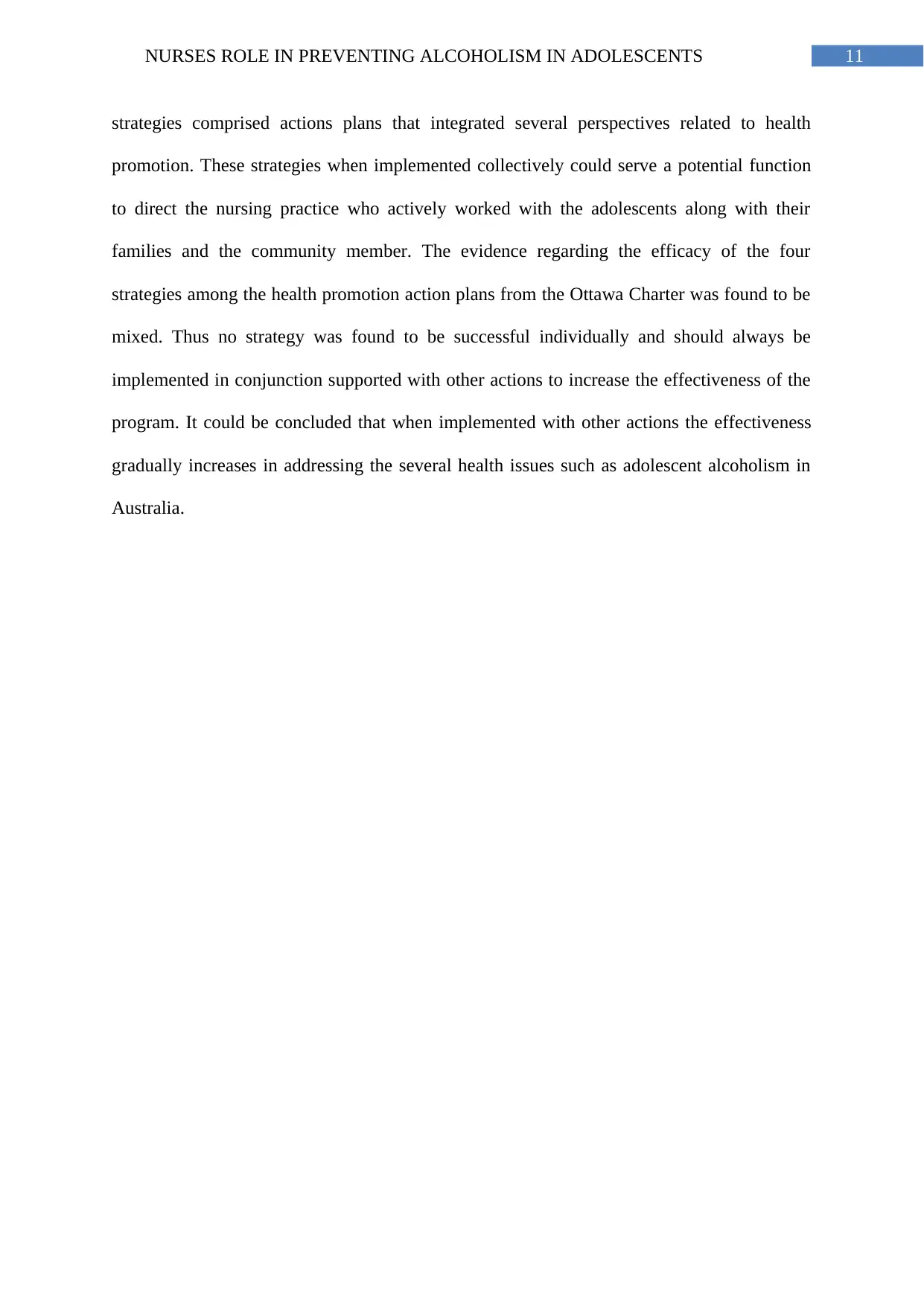
11NURSES ROLE IN PREVENTING ALCOHOLISM IN ADOLESCENTS
strategies comprised actions plans that integrated several perspectives related to health
promotion. These strategies when implemented collectively could serve a potential function
to direct the nursing practice who actively worked with the adolescents along with their
families and the community member. The evidence regarding the efficacy of the four
strategies among the health promotion action plans from the Ottawa Charter was found to be
mixed. Thus no strategy was found to be successful individually and should always be
implemented in conjunction supported with other actions to increase the effectiveness of the
program. It could be concluded that when implemented with other actions the effectiveness
gradually increases in addressing the several health issues such as adolescent alcoholism in
Australia.
strategies comprised actions plans that integrated several perspectives related to health
promotion. These strategies when implemented collectively could serve a potential function
to direct the nursing practice who actively worked with the adolescents along with their
families and the community member. The evidence regarding the efficacy of the four
strategies among the health promotion action plans from the Ottawa Charter was found to be
mixed. Thus no strategy was found to be successful individually and should always be
implemented in conjunction supported with other actions to increase the effectiveness of the
program. It could be concluded that when implemented with other actions the effectiveness
gradually increases in addressing the several health issues such as adolescent alcoholism in
Australia.
⊘ This is a preview!⊘
Do you want full access?
Subscribe today to unlock all pages.

Trusted by 1+ million students worldwide
1 out of 18
Related Documents
Your All-in-One AI-Powered Toolkit for Academic Success.
+13062052269
info@desklib.com
Available 24*7 on WhatsApp / Email
![[object Object]](/_next/static/media/star-bottom.7253800d.svg)
Unlock your academic potential
Copyright © 2020–2025 A2Z Services. All Rights Reserved. Developed and managed by ZUCOL.





